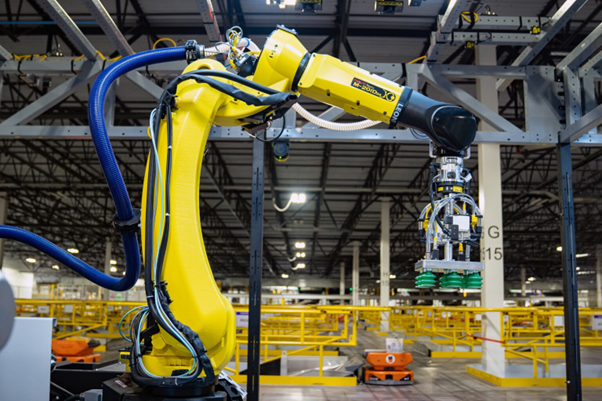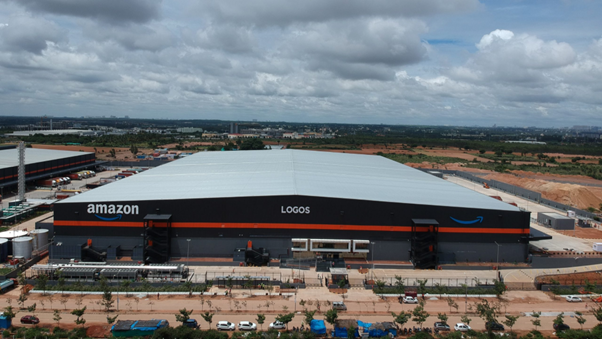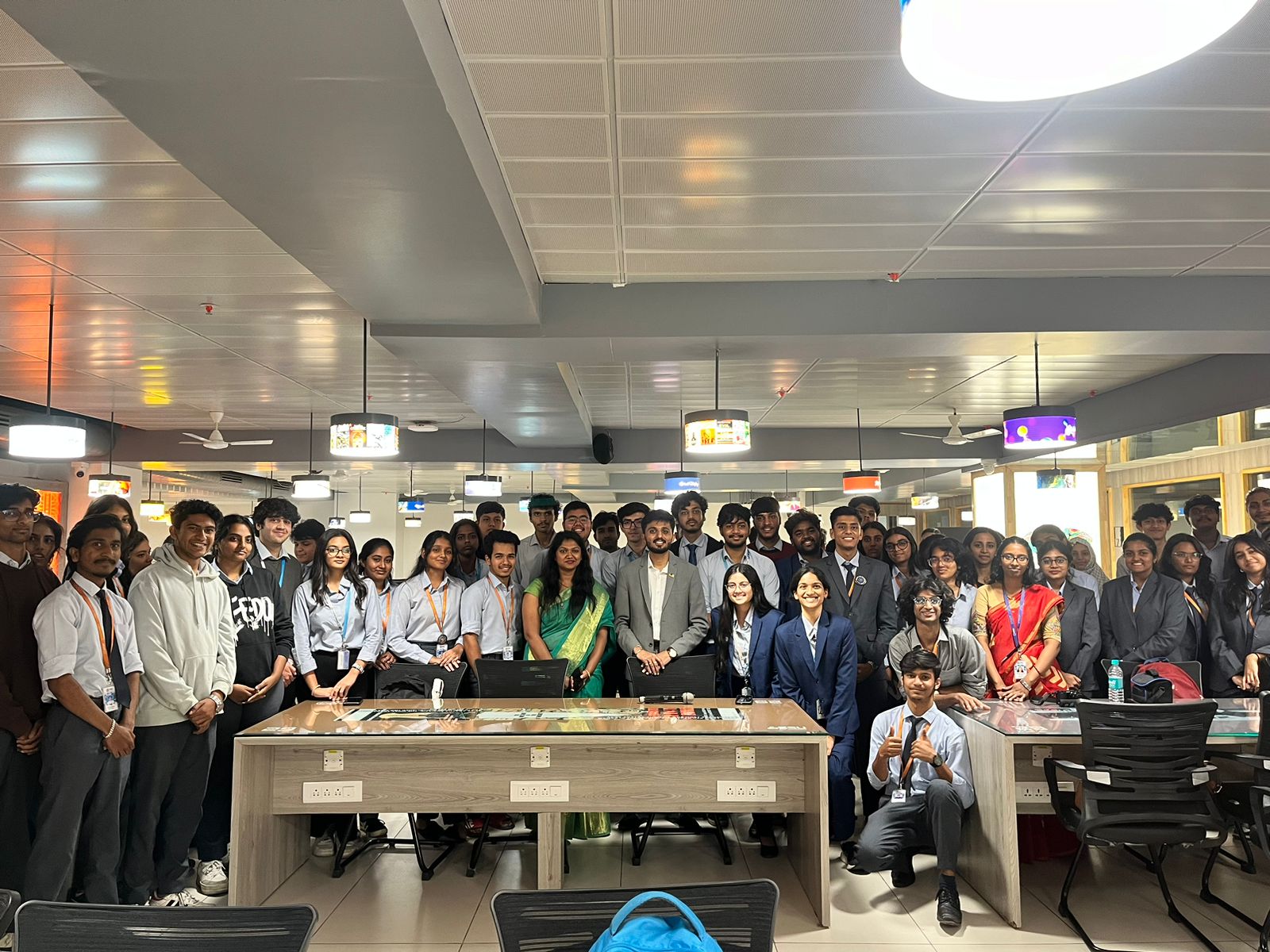
Amazon’s distribution strategy: How Amazon has revolutionized e-commerce with its vast distribution network and focus on customer convenience.
Amazon has become a global giant, transforming the e-commerce industry with its vast distribution network, technological innovation, and relentless focus on customer convenience.
Its efficient logistics and cutting-edge supply chain management have set new standards for the online shopping experience.
By leveraging advanced technologies like automation, artificial intelligence (AI), and a massive distribution infrastructure, Amazon ensures fast, reliable, and convenient delivery, reshaping customer expectations in the e-commerce world.
- Global Fulfilment Network: Reaching Customers Anytime, Anywhere
Amazon’s fulfilment network is one of the most advanced and expansive in the world, allowing it to serve millions of customers globally with rapid delivery times.
The company operates more than 175 fulfilment centres across the globe, with each centre designed to manage a large volume of inventory and process orders efficiently.
- Speed and Reach: Amazon’s distribution centres are strategically located near major urban areas, reducing delivery times and logistics costs. The company’s expansive network ensures that 90% of U.S. customers can receive their orders within two days through Amazon Prime.
- Key Statistic: In 2022, Amazon delivered over 5 billion items globally through its fulfillment network, making it the largest online retailer in the world.
- Prime Delivery: Setting New Standards for Customer Convenience
Amazon Prime’s fast and free delivery model has redefined customer expectations in e-commerce. By offering free two-day delivery, Amazon has set a benchmark for convenience, encouraging millions of customers to sign up for its subscription service. Prime has been a major factor in driving customer loyalty and retention.
- Prime Membership: Amazon Prime subscribers enjoy fast shipping, along with other perks like access to Prime Video, Prime Music, and exclusive discounts. The service has become a cornerstone of Amazon’s customer acquisition and retention strategy.
- Key Statistic: As of 2023, Amazon Prime had over 200 million subscribers globally, with many citing fast shipping as a primary reason for staying subscribed.
Tagline: “Prime Time: Delivering Convenience at Lightning Speed.”
- Automation and Robotics: Improving Efficiency in Distribution
Amazon has invested heavily in automation and robotics to streamline its warehouse operations and improve order processing efficiency. The company’s fulfilment centres are equipped with Amazon Robotics, which helps to reduce human effort in tasks like picking, packing, and sorting items.
- Automation Impact: The use of robots has allowed Amazon to process orders faster, reduce errors, and increase capacity during peak seasons like Black Friday or Prime Day. In some facilities, robots handle up to 85% of the work, allowing for greater operational efficiency.
- Key Statistic: Amazon uses more than 350,000 robots across its fulfilment centres, improving speed and accuracy in order fulfilment.
Tagline: “Robots in Action: Faster, Smarter, and Always on Time.”

- Last-Mile Delivery: Taking Control of the Customer Experience
Amazon has taken significant steps in last-mile delivery, the final leg of the delivery process from the distribution centre to the customer’s doorstep.
By developing its own logistics fleet and working with local delivery partners, Amazon has gained greater control over the last mile, enabling faster and more reliable deliveries.
- Amazon Flex: The Amazon Flex program allows independent drivers to deliver packages, ensuring faster deliveries and flexible service options. This decentralized approach ensures that deliveries can be made even in hard-to-reach areas.
- Key Statistic: Amazon operates over 75,000 delivery vehicles and has 70 air cargo planes, allowing it to handle its own last-mile deliveries rather than relying on third-party carriers like FedEx or UPS.
Tagline: “From Warehouse to Doorstep: The Last Mile That Sets Us Apart.”

- Same-Day and One-Day Delivery: Pushing the Boundaries of Speed
To further cement its dominance in e-commerce, Amazon has introduced same-day and one-day delivery services in select areas, giving customers access to items almost instantly after placing their orders.
This ultra-fast delivery option has revolutionized the shopping experience, making it almost as convenient as visiting a physical store.
- Distribution Centres: Amazon’s regional sortation centres and delivery stations play a crucial role in enabling same-day delivery, strategically placed to allow for quick order processing and dispatch.
- Key Statistic: Amazon’s same-day delivery service is available in over 45 U.S. metropolitan areas, with the company continually expanding its reach.
Tagline: “Today, Not Tomorrow: Delivering Your Desires in Record Time.”
- Sustainability in Distribution: Amazon’s Focus on Green Logistics
Amazon has recognized the importance of sustainability in its logistics operations and is working toward reducing its environmental impact. The company has committed to reducing carbon emissions through initiatives like electric delivery vehicles, renewable energy use, and carbon-neutral shipping options.
- Climate Pledge: In 2020, Amazon co-founded The Climate Pledge, committing to reach net-zero carbon emissions by 2040. Amazon has also started using electric vans for delivery in several cities, with a goal to deploy over 100,000 electric delivery vehicles by 2030.
- Key Statistic: Amazon aims to power its entire global infrastructure with 100% renewable energy by 2025, helping to reduce its environmental footprint.
Tagline: “Delivering a Greener Future, One Package at a Time.”
- Technology and Data: Optimizing Distribution for Efficiency
Amazon uses big data and artificial intelligence to optimize its entire distribution network, ensuring orders are processed and delivered in the most efficient manner possible. By analyzing customer purchasing patterns, delivery routes, and inventory levels in real time, Amazon can predict demand and ensure that the right products are stocked at the right locations.
- Predictive Analytics: Amazon’s algorithms help forecast demand and place products closer to where customers need them, ensuring faster delivery times and lower logistics costs.
- Key Statistic: In 2021, Amazon’s machine learning and AI capabilities helped it handle over 66,000 orders per minute during peak shopping periods like Prime Day.
Tagline: “Smart Deliveries: Harnessing Data for a Seamless Experience.”
Conclusion
Amazon’s distribution strategy has revolutionized e-commerce, setting new benchmarks for customer convenience, speed, and efficiency.
From its global fulfillment network to its investment in automation and green logistics, Amazon continues to push the boundaries of what’s possible in online retail.
By focusing on customer-centric innovations and leveraging advanced technologies, Amazon has redefined the shopping experience and solidified its position as the world’s leading e-commerce platform


https://shorturl.fm/tSQR4
6ua7am
https://shorturl.fm/EbDal
https://shorturl.fm/0fXlj
https://shorturl.fm/QWoRY
https://shorturl.fm/vXz31
https://shorturl.fm/NQ0oZ
https://shorturl.fm/CeiXw
https://shorturl.fm/yLnOb
https://shorturl.fm/bdnA9
https://shorturl.fm/57wkP
https://shorturl.fm/sgzsn
https://shorturl.fm/QaSN0
https://shorturl.fm/FrW5M
https://shorturl.fm/Uppki
https://shorturl.fm/UBLXU
https://shorturl.fm/kmYF4
https://shorturl.fm/G74cN
https://shorturl.fm/ZhpLT
0q92pu
https://shorturl.fm/7gocA
ekjj8y
https://shorturl.fm/O2v8K
https://shorturl.fm/79ILm
https://shorturl.fm/I7dSW
https://shorturl.fm/T1tU6
https://shorturl.fm/Y6ZeO
https://shorturl.fm/yxMR5
https://shorturl.fm/pu7qN
https://shorturl.fm/mtrcu
Awsome website! I am loving it!! Will be back later to read some more. I am bookmarking your feeds also
https://shorturl.fm/URMDG
https://shorturl.fm/L4mnG
https://shorturl.fm/s6JBa
wphb2t
https://shorturl.fm/VaX90
https://shorturl.fm/o4PUS
https://shorturl.fm/4rLlF
https://shorturl.fm/J4AnD
https://shorturl.fm/N1ne5
I have recently started a blog, the information you provide on this site has helped me tremendously. Thanks for all of your time & work. “If you would know strength and patience, welcome the company of trees.” by Hal Borland.
https://shorturl.fm/79R4f
I liked up to you’ll receive carried out right here. The caricature is tasteful, your authored subject matter stylish. however, you command get got an nervousness over that you would like be handing over the following. ill unquestionably come more beforehand again as exactly the same nearly very continuously within case you protect this increase.
https://shorturl.fm/ixmzr
https://shorturl.fm/utEIY
https://shorturl.fm/n46ry
https://shorturl.fm/7C3hF
https://shorturl.fm/XVHcv
https://shorturl.fm/rBt9b
Hello. excellent job. I did not imagine this. This is a great story. Thanks!
I am often to blogging and i really appreciate your content. The article has really peaks my interest. I am going to bookmark your site and keep checking for new information.
https://shorturl.fm/gewR9
https://shorturl.fm/aZDhy
https://shorturl.fm/XAbIu
It is really a great and useful piece of information. I am happy that you simply shared this helpful info with us. Please keep us informed like this. Thank you for sharing.
https://shorturl.fm/LbwqS
https://shorturl.fm/NLgZs
90a2s3
In my opinion you are mistaken. I can defend the position. Write to me in PM, we will talk.
——
яхты на карибах
https://shorturl.fm/qj8XZ
https://shorturl.fm/gyeaQ
https://shorturl.fm/m6OkV
https://shorturl.fm/qnE77
https://shorturl.fm/JjNAh
I reckon something genuinely interesting about your blog so I saved to my bookmarks.
https://shorturl.fm/0CrtE
I absolutely love your blog and find most of your post’s to be just what I’m looking for. Does one offer guest writers to write content for you? I wouldn’t mind creating a post or elaborating on some of the subjects you write about here. Again, awesome website!
https://shorturl.fm/nfGlb
Good write-up, I am regular visitor of one?¦s web site, maintain up the nice operate, and It’s going to be a regular visitor for a lengthy time.
https://shorturl.fm/uvvjT
https://shorturl.fm/oy1KR
https://shorturl.fm/S4Skm
Hey guys, anyone tried 959betlogin lately? Heard some good things, thinking of checking it out. Is it as good as they say? Find it here: 959betlogin
https://shorturl.fm/5mSA1
naturally like your web-site however you have to take a look at the spelling on quite a few of your posts. A number of them are rife with spelling issues and I find it very troublesome to tell the reality however I?¦ll surely come back again.
https://shorturl.fm/ZSaEN
Thanks for this marvellous post, I am glad I discovered this internet site on yahoo.
https://shorturl.fm/OlLdC
I do like the way you have framed this specific matter plus it does indeed offer us a lot of fodder for consideration. However, because of what I have experienced, I just wish when other comments pack on that people continue to be on issue and not start on a soap box of the news of the day. Anyway, thank you for this exceptional piece and though I can not necessarily go along with this in totality, I value your standpoint.
https://shorturl.fm/j8FBx
nhrc6v
Righto, bet99promotions, tell me about these promotions! Keen to see what the deals are like. Show me the money! bet99promotions
Been messing around on rwin99 for a few days. I actually won a bit on their sports bets! The odds aren’t always the best, but they cover a lot of different sports. If you like betting on sports, give rwin99 a shot.
Sprunki Incredibox brings a fresh twist to music creation that feels both innovative and intuitive. It’s amazing how they’ve expanded the sonic palette while keeping the core charm intact. Check it out at Sprunki Incredibox!
G88club, alright! This one’s got a good vibe going on. Feels like everyone’s just hanging out and having a good time. Join the club! Find it here: g88club
Really enjoying exploring new online gaming options! Transparency with RTP (like at bigbunny casino) is a huge plus – knowing the odds makes it more fun. Plus, easy mobile access is key these days! 🎮✨
Feeling like a high roller? 661betvip is calling my name. VIP programs usually mean better perks and faster withdrawals. Sounds good to me! Level up your game 661betvip.
https://shorturl.fm/5ddtb
https://shorturl.fm/8d4Pi
Hello very nice blog!! Guy .. Excellent .. Amazing .. I’ll bookmark your website and take the feeds alsoKI am happy to search out a lot of useful info right here in the publish, we’d like work out more techniques on this regard, thank you for sharing. . . . . .
https://shorturl.fm/Wjc6M
https://shorturl.fm/UocBi
Hi, Neat post. There’s a problem with your web site in internet explorer, could check this… IE nonetheless is the market leader and a huge portion of people will omit your wonderful writing due to this problem.
https://shorturl.fm/snqri
https://shorturl.fm/UB2My
https://t.me/s/officials_1xbet_1xbet
Just want to say your article is as astounding. The clarity in your submit is simply spectacular and i can suppose you are knowledgeable in this subject. Fine along with your permission let me to seize your feed to keep updated with imminent post. Thank you a million and please keep up the enjoyable work.
https://t.me/s/dragon_money_mani/18
I’m impressed, I need to say. Actually not often do I encounter a weblog that’s each educative and entertaining, and let me tell you, you’ve got hit the nail on the head. Your concept is outstanding; the issue is something that not sufficient individuals are talking intelligently about. I’m very comfortable that I stumbled throughout this in my seek for something regarding this.
https://shorturl.fm/2XFJx
This is a must-read for anyone interested in this subjectwell-researched, well-written, and full of insights that you cant find elsewhere.
https://shorturl.fm/kF7dA
Great write-up, I¦m regular visitor of one¦s blog, maintain up the nice operate, and It is going to be a regular visitor for a long time.
Good day! I could have sworn I’ve been to this website before but after reading through some of the post I realized it’s new to me. Nonetheless, I’m definitely glad I found it and I’ll be book-marking and checking back frequently!
Honestly, nilfortuneonline surprised me. The interface is clean and modern, and I’ve been having some good luck there. Give it a look-see! nilfortuneonline
https://shorturl.fm/5GA8X
Thank you for sharing superb informations. Your site is very cool. I’m impressed by the details that you have on this blog. It reveals how nicely you perceive this subject. Bookmarked this website page, will come back for extra articles. You, my friend, ROCK! I found just the information I already searched everywhere and just could not come across. What an ideal web site.
This couldn’t have come at a better time as I was just grappling with this exact challenge in my own project. Your tips saved me hours of trial and error. I especially appreciate how you included both the ‘what’ and the ‘why’ behind each recommendation.
I’ve been following this issue for a while, and your analysis adds a crucial dimension I hadn’t considered before. The historical context you provided helps explain current developments in a way that’s both clear and compelling. This has given me much to think about.
What i don’t understood is actually how you’re not actually much more well-liked than you may be right now. You are so intelligent. You realize thus significantly relating to this subject, made me personally consider it from so many varied angles. Its like men and women aren’t fascinated unless it is one thing to do with Lady gaga! Your own stuffs great. Always maintain it up!
I really like your blog.. very nice colors & theme. Did you create this website yourself or did you hire someone to do it for you? Plz respond as I’m looking to construct my own blog and would like to find out where u got this from. cheers
Pretty section of content. I just stumbled upon your website and in accession capital to assert that I acquire actually enjoyed account your blog posts. Anyway I will be subscribing to your feeds and even I achievement you access consistently fast.
I’ve been surfing online greater than 3 hours today, but I never discovered any interesting article like yours. It¦s lovely value enough for me. In my view, if all site owners and bloggers made excellent content as you probably did, the web will likely be much more helpful than ever before.
You really make it seem really easy along with your presentation however I in finding this matter to be really one thing which I feel I would by no means understand. It sort of feels too complex and extremely wide for me. I am taking a look ahead on your next publish, I will try to get the hold of it!
Fantastic web site. A lot of useful info here. I am sending it to several pals ans also sharing in delicious. And certainly, thanks on your effort!
Thank you for the sensible critique. Me and my neighbor were just preparing to do a little research about this. We got a grab a book from our local library but I think I learned more clear from this post. I’m very glad to see such excellent information being shared freely out there.
https://shorturl.fm/7uERe
Keep functioning ,terrific job!
https://shorturl.fm/3BpwU
https://shorturl.fm/zLaMv
Yo! aog7777 is where it’s at! The place is amazing bro. give it a try yourself ASAP.
Your article helped me a lot, is there any more related content? Thanks! https://www.binance.com/el/register?ref=DB40ITMB
naturally like your web-site but you have to test the spelling on quite a few of your posts. Several of them are rife with spelling problems and I find it very troublesome to tell the reality however I will certainly come back again.
I like this web blog so much, saved to fav. “Nostalgia isn’t what it used to be.” by Peter De Vries.
I am impressed with this website , very I am a fan.
https://shorturl.fm/D21iI
https://shorturl.fm/weyqq
You are a very capable individual!
Your article helped me a lot, is there any more related content? Thanks!
Thank you for the good writeup. It in fact was a amusement account it. Look advanced to far added agreeable from you! By the way, how could we communicate?
https://shorturl.fm/seRL9
Hi there! I thought I’d visited your blog before, but after reading a few articles I realized it’s actually new to me. Either way, I’m really glad I found it and will definitely bookmark it to visit again often!